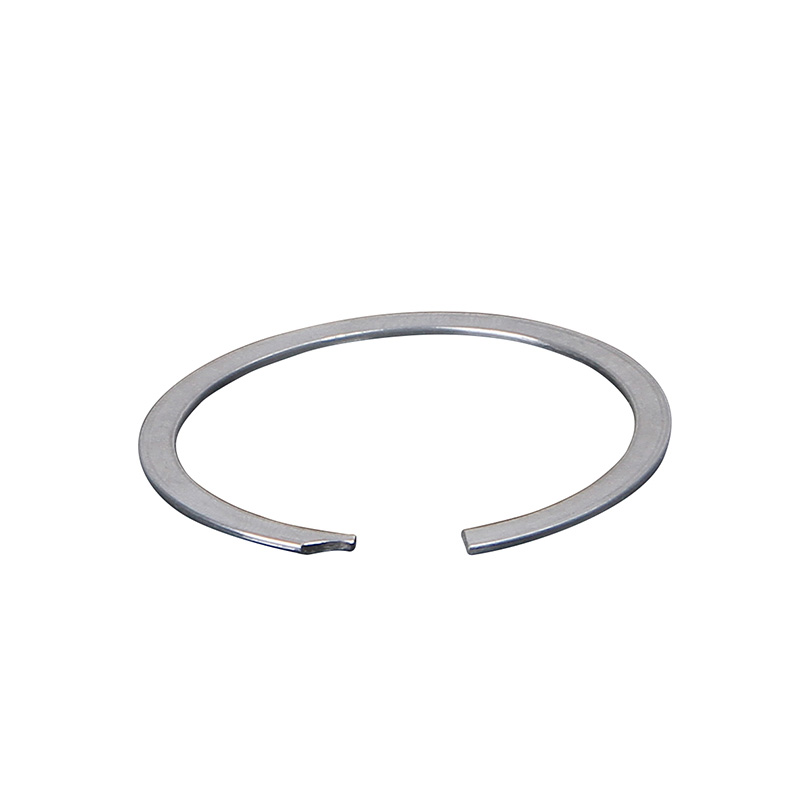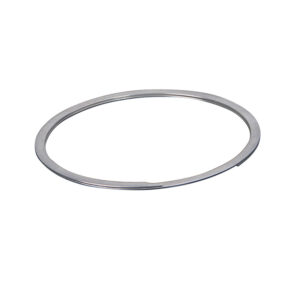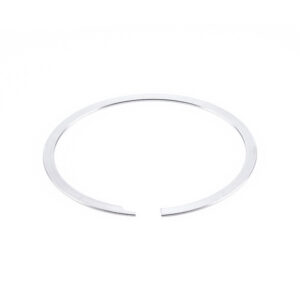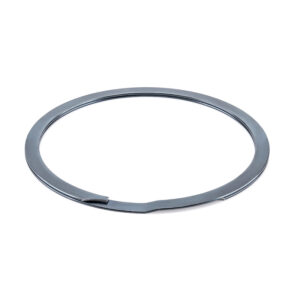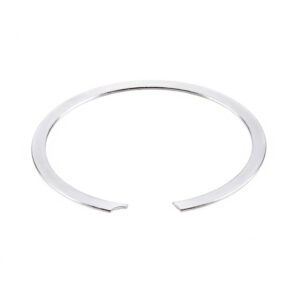SKU
8e03a61fcdf6
Categories Internal Spiral Retaining Rings, Spiral Retaining Ring
Product Description
Light Duty Single Turn Internal Spiral Retaining Rings for Hole Stainless Circlips
Description:
Spiral retaining rings have no ears in your assembly! Spiral retaining rings are manufactured by coiling the ring from flat wire. Because coiling produces a retaining ring with no scrap, the spiral retaining ring can be economically produced in carbon steel, stainless steel, copper, and many other alloys.
- No gap; 360° retaining surface.
- Economically produced in stainless steel because the coiling process produces no scrap.
- No charge on custom designs.
- Easy installation and removal
A spiral retaining ring, also known as a spiral elastic retaining ring, is rolled from flat metal wire and has good elasticity and toughness after heat treatment and surface treatment. For shafts and holes, single-turn, double-turn, and multi-turn according to different loads are used for axial positioning.
Features
The spiral retaining ring has the following characteristics:
- No notch—the profile is a continuous circumference with full contact with the fitting;
- The inner circle is smooth and complete and does not interfere with the mating parts.
- No burrs on the inner and outer diameters, easy disassembly and assembly;
- No corner waste is generated in the production process, saving materials;
- There is no need for molds, and the production cycle is short. By changing the thickness of the material and the number of turns, it can be easily made into light loads, medium loads, and heavy loads.
Scope of Application
Spiral retaining rings are widely used in hydraulic parts assembly, valves, instruments, various lock core components, needle roller bearings, pulleys, connectors, quick connectors, and other mechanical assemblies.
Processing Steps
Design → Drawing → Flatten the wire → CNC Machining → Heat treatment → Surface → Finishing → Quality Inspection → Packing
Primary Competitive Advantage
- High-quality products;
- Competitive price (factory direct price);
- Good service;
- Quick reply and production time
- long-time experience;
- Free samples if we have stock;
- Good problem-solving ability.
Spiral retaining rings are a type of retaining ring that uses a spiral groove to hold the ring in place. They are ideal for applications where space is limited, and they can be used with or without a retaining wall. A spiral retaining ring is a type of ring that has a spiral-shaped groove on the inside diameter. This groove allows the ring to be installed on a shaft by being compressed onto the shaft. Once the ring is in place, the groove expands and locks the ring in place.
How do spiral retaining rings work?
Spiral retaining rings work by using a spiral shape to hold a shaft in place. This spiral shape creates a friction fit that holds the shaft in place. This is a very effective way to hold a shaft in place, and it is very reliable.
When are spiral retaining rings used?
Spiral retaining rings are often used in applications that require a large amount of radial force. They are also used when there is a need to maintain the alignment of the shaft and bore.
What are the benefits of using spiral retaining rings?
- They are very strong and can hold a lot of weight.
- They are very durable and can last for a long time.
- They are easy to use and can be installed quickly.
- They are affordable and can be cost-effective compared to other types of retaining rings.
- They are compact and can take up less space than other types of retaining rings.
- They are corrosion-resistant and can withstand harsh weather conditions.
- They are safe to use and can be a good option for people who are looking for a safe and reliable retaining ring option.
How do you choose the right spiral elastic retaining ring for your application?
There are a few factors that you need to consider when choosing the right spiral elastic retaining ring for your application. The size and shape of the part you are trying to retain, the force required to retain the part, and the environment the part will be in are all important factors to consider.
The size and shape of the part you are trying to retain are important because you need to make sure the ring will fit around the part. The force required to retain the part is important because you need to make sure the ring can withstand the force that is being applied to it. The environment the part will be in is important because you need to make sure the ring can withstand the conditions it will be exposed to.
How are spiral elastic retaining rings different from traditional retaining rings?
Spiral elastic retaining rings are different from traditional retaining rings in a few ways. First, spiral elastic retaining rings are made of elastic material, which allows them to stretch and contract as needed. This makes them ideal for use in applications where the surrounding material may flex or change size. Second, spiral elastic retaining rings have a spiral-shaped groove on the inside surface, which helps them grip the surrounding material more securely. This makes them less likely to slip out of place, even under heavy loads. Lastly, spiral elastic retaining rings are more flexible than traditional retaining rings, making them easier to install and remove.
Factors to consider when choosing a spiral retaining ring
When choosing a spiral retaining ring, there are several factors to consider, including:
- Diameter: The diameter of the ring must match the diameter of the shaft or component on which it will be installed.
- Width: The width of the ring must match the width of the groove in which it will be installed.
- Material: Spiral retaining rings are typically made of spring steel, stainless steel, or other durable materials. You should choose a material that is compatible with the application and that can withstand the environmental conditions in which the ring will be used.
- Load capacity: The ring must be able to withstand the forces that will be exerted on it during normal operation.
- Corrosion resistance: If the ring will be used in an environment where corrosion is a concern, it should be made of a material that is resistant to rust and other forms of corrosion.
- Temperature range: The ring should be able to operate within the temperature range of the application.
- Ease of installation: It is important to consider the ease of installation of the ring and how it will be installed. Some rings are designed to be installed with a tool, while others can be installed by hand.
- Brand reputation: It is always a good idea to consider the reputation of the manufacturer when choosing a spiral retaining ring, so you can be sure you are getting a quality product that meets your needs.
- Compliance: It is important to check if the ring is compliant with any relevant industry standards or regulations, such as those set by ASTM, ASME, or ANSI.
By considering these factors, you can be sure to select a spiral retaining ring that is well-suited to your application and will provide reliable performance over time.
Specification:
(Some specifications and sizes can be contacted for details.)
| Part Number | Ring Size | Assembly Size | ||||||
| Spec. | Use | OD. (mm) |
Radial Wall (mm) |
Thickness (mm) |
Turns | Housing Diameter (mm) |
Groove Diameter (mm) |
Groove Width (mm) |
| VKM-140 | Internal | 145 | 5.72 | 1.55 | Single Turn | 140 | 143.5 | 1.7 |
| VKM-145 | Internal | 150.17 | 5.72 | 1.55 | Single Turn | 145 | 148.62 | 1.7 |
| VK-575 | Internal | 151.21 | 5.72 | 1.55 | Single Turn | 146.05 | 149.71 | 1.7 |
| VKM-150 | Internal | 155.3 | 6.73 | 1.55 | Single Turn | 150 | 153.76 | 1.7 |
| VK-600 | Internal | 157.78 | 6.73 | 1.55 | Single Turn | 152.4 | 156.21 | 1.7 |
| VKM-155 | Internal | 160.46 | 6.73 | 1.55 | Single Turn | 155 | 158.88 | 1.7 |
| VK-625 | Internal | 164.34 | 6.73 | 1.55 | Single Turn | 158.75 | 162.71 | 1.7 |
| VKM-160 | Internal | 165.64 | 6.73 | 1.55 | Single Turn | 160 | 164 | 1.7 |
| VKM-165 | Internal | 170.82 | 6.73 | 1.55 | Single Turn | 165 | 169.13 | 1.7 |
| VK-650 | Internal | 170.94 | 6.73 | 1.55 | Single Turn | 165.1 | 169.24 | 1.7 |
| VKM-170 | Internal | 175.99 | 6.73 | 1.55 | Single Turn | 170 | 174.25 | 1.7 |
| VK-675 | Internal | 177.5 | 6.73 | 1.55 | Single Turn | 171.45 | 175.74 | 1.7 |
| VKM-175 | Internal | 181.17 | 6.73 | 1.55 | ||||
Spiral retaining rings, also known as spiral rings or spiral circlips, are essential components in the mechanical engineering and manufacturing industries. These small yet mighty fasteners play a crucial role in securing various components within assemblies, preventing unintentional dislodgment or movement. In this comprehensive article, we will delve into the world of spiral retaining rings, exploring their design, functionality, applications, and the many advantages they offer to engineers and manufacturers.
I. Understanding Spiral Retaining Rings
1.1 What are spiral-retaining rings?
Spiral retaining rings are versatile fasteners designed to hold components in place on a shaft or in a housing bore. They are typically made of spring steel or stainless steel and feature a unique spiral design that allows them to be installed and removed with ease while maintaining a secure grip on the mating parts.
1.2 Design and Structure
These rings come in various shapes and sizes, with common configurations including internal and external spiral retaining rings. Internal rings fit inside a bore, while external rings sit on the outside of a shaft. The spiral shape of these rings provides radial flexibility, allowing them to expand or contract to accommodate different tolerances.
II. Functions and Applications
2.1 Functions of Spiral Retaining Rings
Spiral retaining rings serve several essential functions in mechanical assemblies, including:
- a. Axial Positioning: They ensure that components remain in their intended axial positions, preventing axial movement.
- b. Preventing Axial Play: These rings eliminate unwanted axial play, reducing vibration and noise in machinery.
- c. Holding Components in Place: Spiral rings securely hold bearings, gears, pulleys, and other components in position.
- d. Cost-Effective Solutions: They are cost-effective alternatives to traditional snap rings and other retention methods.
2.2 Applications Across Industries
Spiral retaining rings find applications in a wide range of industries, including:
- a. Automotive: Used in transmissions, engines, and suspension systems.
- b. Aerospace: Employed in aircraft engines and landing gear systems.
- c. Manufacturing: Used in machinery, conveyor systems, and industrial equipment.
- d. Medical Devices: Employed in precision medical instruments.
- e. Electronics: Used in electronic connectors and assemblies.
- f. Consumer Products: Found in various household appliances and power tools.
III. Advantages of Spiral Retaining Rings
3.1 Reliability and Durability
Spiral retaining rings are known for their reliability and durability. They can withstand high temperatures, corrosive environments, and heavy loads, making them ideal for demanding applications.
3.2 Easy Installation and Removal
Their unique design allows for easy installation and removal, reducing assembly time and maintenance costs. Unlike traditional snap rings, spiral retaining rings do not require special tools for installation or removal.
3.3 Space Efficiency
These rings are compact and space-efficient, making them suitable for applications with tight constraints. Their low-profile design minimizes interference with adjacent components.
3.4 Cost-Effective
Spiral retaining rings are cost-effective solutions for component retention. Their ease of installation and reusability further contribute to cost savings.
Choosing the Right Spiral Retaining Ring
4.1 Factors to Consider
When selecting spiral retaining rings for a specific application, several factors must be taken into account:
- a. Material: Choose a material that suits the environmental conditions, such as stainless steel for corrosion resistance or carbon steel for general applications.
- b. Size and Configuration: Ensure that the ring size and configuration match the shaft or bore dimensions.
- c. Load Capacity: Consider the load capacity and expected forces the ring will experience.
- d. Operating Temperature: Account for the temperature range in which the ring will operate.
- e. Special Requirements: Some applications may require rings with special coatings or finishes.
4.2 Customization Options
Manufacturers often offer customization options for spiral retaining rings, allowing engineers to tailor the rings to their specific needs. Customization may involve altering the material, dimensions, or special features to meet unique application requirements.
V. Maintenance and Installation Tips
5.1 Installation Guidelines
Proper installation of spiral retaining rings is crucial for their effectiveness. Follow these guidelines:
- a. Ensure clean and smooth mating surfaces.
- b. Use the appropriate installation tool or method for the specific type of ring.
- c. Confirm that the ring is correctly seated in its groove.
5.2 Regular Inspection and Replacement
Routine inspection of retaining rings is essential to detect wear, damage, or signs of fatigue. If any issues are identified, timely replacement is necessary to prevent failures and maintain the integrity of the assembly.
VI. Future Trends and Innovations
6.1 Advanced Materials
Ongoing research and development efforts are focused on creating new materials for spiral retaining rings that offer improved performance, including enhanced corrosion resistance, higher load capacities, and increased temperature tolerance.
6.2 3D Printing
The adoption of 3D printing technology in manufacturing is expanding the possibilities for custom-designed and highly specialized spiral retaining rings, allowing for even more precise and efficient solutions.
6.3 Smart Retaining Rings
Incorporating sensors and monitoring capabilities into retaining rings is a developing trend, enabling real-time data collection and analysis to optimize maintenance schedules and increase overall system reliability.
Spiral retaining rings may be small in size, but their significance in mechanical engineering and manufacturing cannot be overstated. These versatile fasteners play a crucial role in ensuring the reliability, durability, and safety of various applications across industries. Their easy installation, cost-effectiveness, and adaptability make them an indispensable component for engineers and manufacturers worldwide. As technology continues to advance, the importance of spiral retaining rings in enhancing the performance and longevity of mechanical assemblies will only grow.

